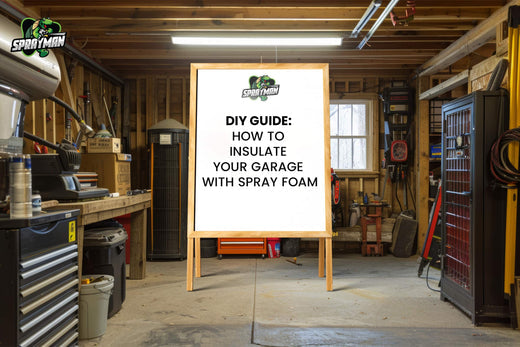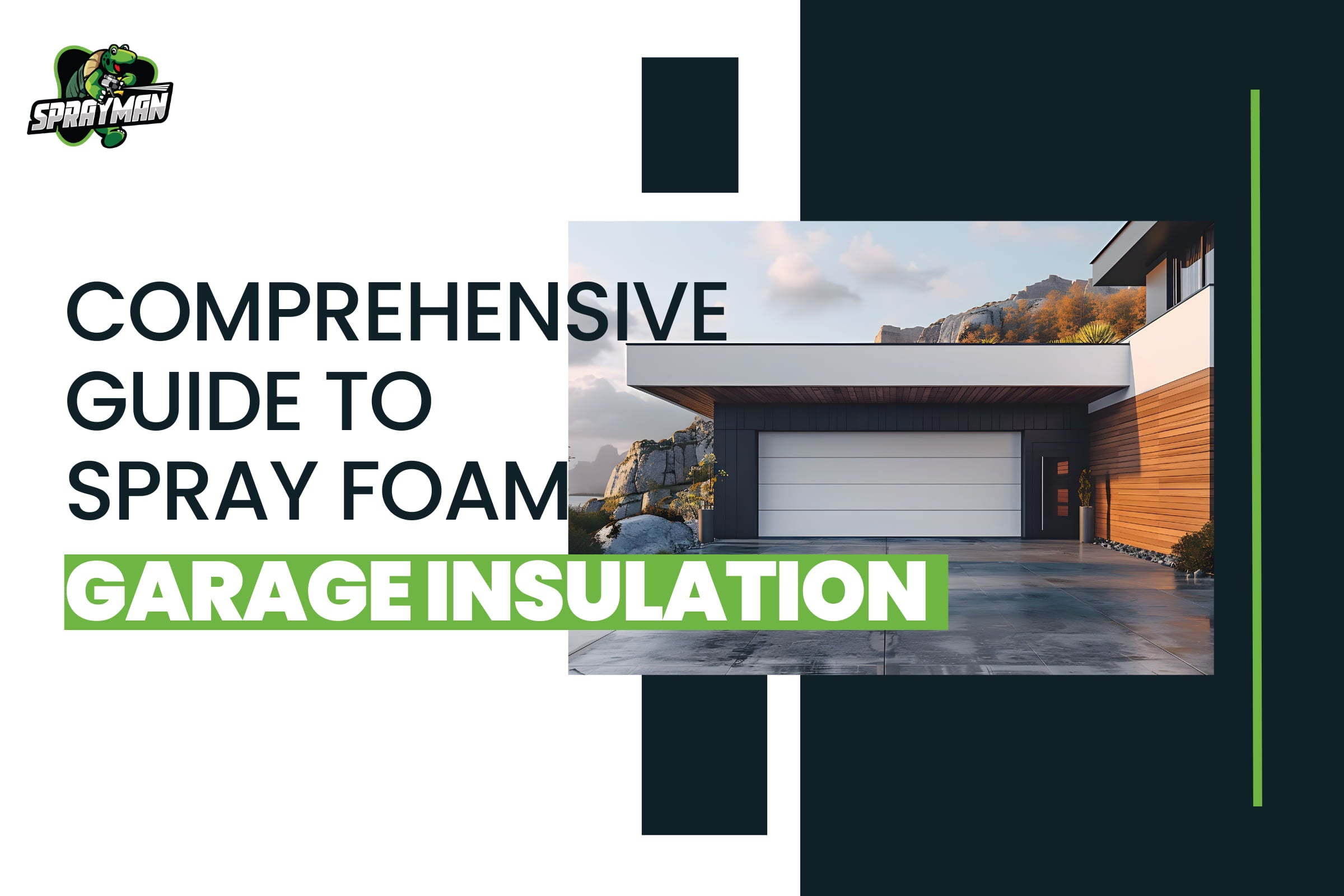Save up to $2,000 in labor costs by learning how to insulate a garage yourself. One of the main reasons homeowners neglect garage insulation is the high cost of labor.
Garage insulation is a crucial step in maintaining energy efficiency and comfort. Insulating your garage reduces energy costs, helps regulate temperature, keeps your stored items safe, and adds to your home's overall value.
Spray foam insulation provides an excellent solution to keep your garage comfortable and energy efficient.
In this guide, we’ll walk you through everything you need to know about spray foam garage insulation, from determining which areas to insulate, the recommended R-values, to a comprehensive step-by-step installation guide. Whether you're considering a DIY approach or hiring a professional, this guide covers all the bases to ensure you make informed decisions for your garage insulation project.
This detailed DIY guide will teach you how to insulate a garage like a Pro using spray foam.

Why Insulating Your Garage Is Important?
Insulation for garage reduces energy costs in your home by 15%. This is because insulation creates a thermal barrier that helps improve energy efficiency in your garage. Insulation envelopes the entire garage and building, protecting your car battery and other items from unfavorable weather conditions.
Garage insulation offers significant benefits to the overall comfort of your home. Insulation is a must if you have a heating system installed in the garage. Another reason to insulate a garage is when it is attached to your conditioned living area. Insulating your garage reduces hot or cold air from the garage entering your house.
Insulating a garage with spray foam insulation offers much more. Spray foam insulation effectively seals tiny holes and gaps that can cause air infiltration into the garage. Drafts, cold floors, mold growth, and noise are some problems that can be eliminated just by installing a spray foam garage. Learn more about these benefits in our comprehensive guide to spray foam garage insulation.
Where to Insulate a Garage?
Garage insulation is essential if you have a heating system installed or if it is attached to your conditioned living area. Neglecting to insulate attached garages significantly reduces energy efficiency in your insulated living area.
Here is an expert opinion: Insulate areas in a garage that are attached to the main living area.
Does Your Garage Attic Need Insulation?
Insulating your garage attic is crucial for maintaining a stable temperature, especially if the garage is attached to your home. Insulating the attic reduces the heat transfer between the garage and outside. Insulating your garage attic improves energy efficiency and reduces energy consumption.
Is Insulating Your Garage Roof or Ceiling Important?
Yes, insulating the garage roof or ceiling is essential for improving energy efficiency and protecting the structural integrity of your garage. Furthermore, insulation for a ceiling is necessary if there is a conditioned space above it. Insulating a garage roof helps to prevent heat transfer through it.
Heat travels easily from the garage ceiling to the floor above, causing discomfort and high energy consumption. Insulating the roof improves energy efficiency by reducing heat transfer in the garage. Extreme temperature conditions have negative effects on the roof. This reduces the lifespan of your roof. Spray foam insulation on garage roofs improves structural integrity and durability. In addition, insulation in garage ceiling adds to the resale value of your home.
Are Garage Roof Rafters Worth Insulating?
Insulating roof rafters improves energy efficiency and comfort in garages. In garages where the ceiling is directly connected to the roof rafters, adding insulation to the rafters is a crucial step. Insulation makes the garages warmer during winter and cooler in summer. Insulating garage roof rafters offers more than comfort, it prevents moisture damage.

How Important Is Garage Wall Insulation?
Garage wall insulation is beneficial in several ways. Wall insulation is necessary to convert your garage for other purposes such as a workshop or office. Insulating garage walls helps in temperature regulation and improving comfort. Insulating garage walls prevents moisture problems and reduces noise.
In attached garages, insulation for walls reduces heat transfer between the wall and the main building. This helps in reducing the energy consumption required to cool or heat the garage. In contrast, garage wall insulation is not a critical topic when it is not heated or frequently used. Nevertheless, wall insulation provides a stable temperature in garages in extreme weather conditions.
Why Consider Insulating Your Garage Floor?
Insulation is essential if you plan on making the garage conducive for you and your car. Garage floor insulation improves comfort in a garage by reducing cold seeping through the ground. Insulation reduces energy consumption in heated garages.
Garage floor insulation is essential in cold climates. Insulation eliminates cold floors in garages, making the garage useful for other purposes. Furthermore, insulating your garage floor will prevent moisture buildup, condensation problems, and noise.
Is Garage Door Insulation Essential?
Garage door insulation is very vital for all types of garages. A garage door is a major entry point for heat transfer. Insulation adds extra stability and durability to your garage door. A properly insulated will help achieve a consistent temperature at all times, reducing energy consumption to the minimum. For specific details on insulating your garage door for maximum efficiency, check out our dedicated guide.
Converting a garage to other purposes such as a workshop or office means soundproofing will be needed. Insulating a garage door helps reduce noise effectively. By insulating a garage door, you can block sound from entering or leaving the garage. Furthermore, a properly insulated garage door provides safety from burglary or break-ins. This is because the doors become thicker and reinforced after adding insulation.
How to Insulate a Garage?
As a homeowner, learning how to insulate a garage requires proper preparations and safety precautions. The cheapest way to insulate a garage is by using do-it-yourself spray foam insulation. For more information on cost-effective garage insulation options, see our detailed cost guide.
In this section, we will discuss common safety precautions, preparation steps, tools needed, and a detailed step-by-step guide to ensure a successful installation, covering everything from how to insulate a garage ceiling to how to insulate a garage attic.
What Safety Precautions Are Necessary?
As a DIYer, here are the necessary safety precautions to avoid injuries and ensure a successful installation:
- Personal Protective Equipment: Always put on personal protective equipment during installation. Use a face mask to prevent inhaling fumes and harmful air particles. Protect your skin and eyes by wearing overalls and gloves.
- Ventilation: The garage should be well-ventilated to reduce exposure to harmful air particles. Open windows and doors to circulate air during and after the application of spray foam.
- Avoid Heat Sources: To reduce the flammability of spray foam, avoid contact with heat sources such as electrical wiring.
What Preparation Steps Are Necessary?
The preparation steps necessary to achieve a smooth DIY garage spray foam installation process include the following;
- Clear the garage from obstructions such as dirt and debris.
- Remove old insulation before installing a new one.
- Ensure the garage is completely dry before installation by fixing water leaks or mold problems.
- Turn off all electrical components before installation.
- Seal small gaps in the garage using caulks and sealants.
What Tools and Materials Do You Need?
Here is a detailed list of tools needed to insulate a garage using spray foam insulation properly.
- SPRAYMAN Spray Foam Thermal and Sound Insulation
- DIY Spray Foam Insulation Kit (Protective gear, spray gun)
- Utility knife
- Ladder
- Vapor barrier
- Finishing material (drywall, plywood)
What Is the Step-By-Step Guide for DIY Installation?
Insulating a garage is tedious as there are 4 important areas to cover; the ceiling / attic, wall, floor, and door. Insulation begins after getting the necessary tools and carrying out the preparatory steps. As a homeowner, here’s how to insulate a garage using spray foam insulation.
Step 1: Preparation
Follow the preparatory steps listed above.
Step 2: Get the Tools
Get the necessary tools needed for insulation starting with spray foam insulation products. The best insulation for garages is SPRAYMAN Spray Foam Thermal and Sound Insulation.
Step 3: Spray Foam Application
Apply the spray foam in different areas. Starting with wall insulation before moving to the ceiling. Here is how to insulate different areas in a garage:
-
Garage Wall Insulation
Apply the foam directly on the wall studs.
-
Garage Ceiling Insulation
Spray foam the ceiling by applying the insulation between the joists.
-
Garage Attic Insulation
Spray foam the attic by applying it between the attic rafters. Create an air seal in the attic by allowing the foam to expand and fill gaps.
-
Garage Door Insulation
Apply spray foam directly on the panels of garage doors in thin layers.
Avoid over-applying on the door.
Cover the door with a vapor barrier or paint over it to add aesthetics.
-
Garage Floor Insulation
Remove the flooring material and cover the floor using spray foam.
Avoid overfilling the floor.
Step 4: Curing Time
Allow the foam to dry for at least 24 hours.
Step 5: Remove Excess Foam
Remove excess foam from the wall to get an even finish.
Step 6: Inspection
Inspect the insulation for missed spots or cracks.
Step 7: Install Finishing Materials
Cover different areas with drywall to achieve an even finish.
Mistakes to Avoid When Insulating Your Garage
When insulating your garage with spray foam, avoiding these 6 common mistakes is crucial for achieving the best results:
- Skipping Preparation: Not properly preparing the garage (cleaning surfaces, sealing gaps) before applying spray foam can lead to poor adhesion and ineffective insulation.
- Using the Wrong Spray Foam: Choosing the incorrect type of spray foam (open-cell vs. closed-cell) for your specific garage needs can result in suboptimal insulation performance.
- Over- or Under-Application: Applying too much or too little spray foam can compromise the insulation’s effectiveness. Over-application can lead to waste and unnecessary cost, while under-application may leave gaps and cold spots.
- Ignoring Safety Precautions: Failing to use proper protective gear and ventilation during the application process can lead to health risks and potential hazards.
- Neglecting R-Value Considerations: Not considering the recommended R-values for different parts of the garage (walls, ceiling, doors) can result in inadequate insulation performance.
- Not Hiring a Professional When Necessary: Attempting a DIY insulation job without the necessary skills or tools can lead to costly mistakes. It's sometimes more economical to hire a professional.

What R-Value Is Recommended for Garage Insulation?
The R-value of an insulation depicts its level of thermal resistance. This means an insulation with a higher R-value will offer a higher resistance to heat transfer. The R-value for spray foam insulation is highest, the lowest being the R-value for fiberglass insulation. The recommended R-value for a garage is the thermal resistance required for proper insulation. Now, let us take a look at the recommended R-value for different areas in a garage.
What R Value for Garage Ceiling
In general, the required ceiling insulation R-value is R30 -R40. Garage ceiling insulation R-value is largely dependent on whether there is a conditioned space above the ceiling or not. For instance, the recommended R-value when insulating garage ceiling under bedroom will be R30. On the other hand, the recommended R-value is R38 when the ceiling goes straight into the rafters.
What R Value for Garage Walls
The recommended R-value for insulating garage walls is R13 - R21. The minimum R-value for walls is ideal in warm climates. In colder climates, it's essential to use an R-value closer to R21 for optimal insulation.
What R Value for Garage Door
The required R-value for garage door insulation is R8 - R12. This is because of the limited space in the door. For unheated garages or warm climates, an R-value of R8 - R9 is sufficient. An R-value of R12 is used in cold climates and heated garages.
How to Maintain Spray Foam Insulation in a Garage?
Maintenance is vital to keep the spray foam insulation in a garage effective. Here are 3 tips on how to maintain spray foam insulation in a garage;
- Regular visual inspection of insulation.
- Seal gaps and cracks immediately.
- Hire a professional for routine maintenance.
FAQs
What Are the Other Types of Insulation for Garages?
Spray foam is excellent for garages, but there are other options like fiberglass and rigid foam. Each type has its advantages. For a detailed comparison, check out our guide to spray foam garage insulation.
Is Garage Attic Insulation Worth It?
Yes, garage attic insulation is definitely worth it. It helps regulate temperature in the garage, keeping it stable and reducing energy bills in your home. Insulating the attic with the right insulation will solve moisture and noise problems in your garage.
Can Spray Foam Insulation Be Used on Any Type of Roof?
Spray foam can adhere easily to different materials such as wood, ceramic, metal, and plastics. Spray foam is the best insulation for garages because of its versatility.
How Long Does Spray Foam Insulation Last on a Roof?
With proper maintenance, spray foam insulation can last up to 20 years on a roof without replacement. Spray foam insulation provides superior durability than other insulation types.
Do I Need a Vapor Barrier in my Garage?
Vapor barriers are used to control moisture. Closed-cell spray foam insulation provides excellent resistant against moisture. Nonetheless, you can install vapor barriers in garage floors, ceilings, walls, and doors to prevent moisture buildup.
Do You Need Ventilation in an Insulated Garage?
Ventilation is important in an insulated garage. Ventilation allows fresh air to circulate through the garage, eliminating potentially hazardous fumes from your cars.




Leave a comment
This site is protected by hCaptcha and the hCaptcha Privacy Policy and Terms of Service apply.